Understanding ArchiMate Viewoints Mechanism
To develop and maintain an enterprise architecture requires the cooperation between different people, teams and even organizations. These stakeholders have different backgrounds, expertise and responsibilities and have different interests, goals and needs. If there is a means to allow stakeholders to focus on particular aspects of an enterprise architecture, conerns can be better addressed, and this is what ArchiMate's viewpoint aimed to to achieve.
Viewpoint allows enterprise architects, designers and any other stakeholders involved in building, maintaining and participating in an enterprise architecture to define their own views on the architecture. Stakeholders views the portions they are interested in and avoid reading information that they do not care as much about.
In this page, you will learn how to add a standard viewpoint which is suggested by OpenGroup ArchiMate 3.0 specification and how to create your own viewpoint.
Adding a Standard Viewpoint
A set of standard viewpoints have been suggested by OpenGroup. In this section, you will learn how to add a standard viewpoint.
- Select Modeling > Manage Viewpoints... from the toolbar.
- In the Viewpoint Management window, the Viewpoint tab is opened by default.

Manage viewpoints - At the bottom left, click Add.

Add a Viewpoint - A list of standard viewpoints are listed, known as the predefined viewpoints. Check the ones that are required by your enterprise architecture (project).
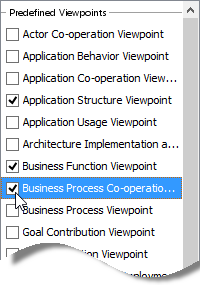
Add standard viewpoints to enterprise architecture - Click Done at bottom left to confirm your selection.
- Each predefined viewpoint comes with a set of preset properties such as stakeholders, layers, purpose, abstraction level, concerns and aspects. You may change them by first selecting the viewpoint you want to change on the left hand side and editing the fields on the right hand side. Here is a description of properties:
Property Description Name Name of the viewpoint. Architecture Stakeholders People who view the enterprise architecture through the viewpoint. Layer The perspective involved. The selection affects the visibility of tools that are available in diagram toolbar in ArchiMate diagram. Purpose One of the two dimensions in classifying a viewpoint. The Purpose dimension allows the classification of viewpoint base on the purpose of view.
Designing - Support architectures and designers in the design process.
Deciding - Assists stakeholders in decision-making.
Informing - Inform stakeholders who have a need in understanding the enterprise architecture.Abstraction Level One of the two dimensions in classifying a viewpoint. The Abstract Level dimension classify viewpoint base on the level of detail of a view.
Details - Typically consider one layer and one aspect from the ArchiMate framework.
Coherence - Multiple layers or multiple aspects are spanned.
Overview - Addresses both multiple layers and multiple aspects.Concerns Conerns of stakeholders to be addressed by the viewpoint. Aspects Certain aspects of enterprise architecture. Caption Here 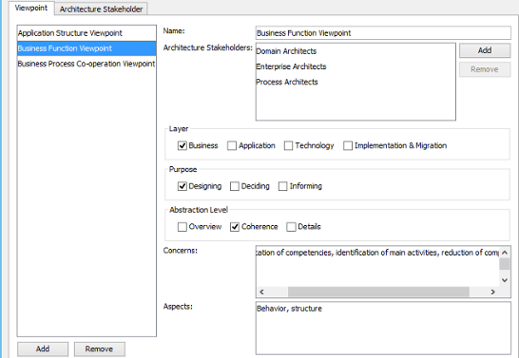
Properties of a viewpoint - Click OK to confirm viewpoint management and close the window.
Creating Your Own Viewpoint
Instead of using standard viewpoints, you may also define your own viewpoints, with your own stakeholders. To create your own viewpoint:
- Select Modeling > Manage Viewpoints... from the toolbar.
- In the Viewpoint Management window, select the Viewpoint tab.
- At the bottom left, click Add.
- Click New.
- Enter the name of the stakeholder.
- You may optionally add the stakeholder to existing viewpoints now.
- Specify the documentation.
- At the bottom left, click Done to confirm the creation of stakeholder.
Assign a Viewpoint to Diagram (i.e. View in ArchiMate)
Once you have added or created a viewpoint, you can assign the viewpoint to diagram(s). The diagram with viewpoint specified is supposed to be designed for the stakeholders listed in that viewpoint. To set viewopoint, right click on the diagram and select Open specification, open its Viewpoint tab and set viewpoint there.
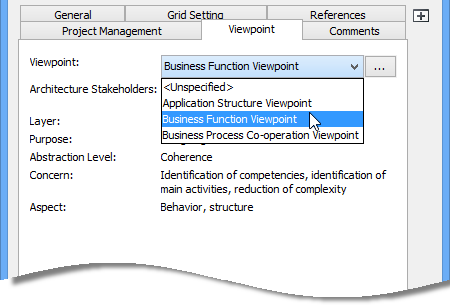 |
| Set viewpoint via diagram specification window |
Creating a Stakeholder
When you add a standard viewpoint, the stakeholders involved will be added to your project automatically. In addition to these 'default stakeholders', you can create your own to suit your business and problem domain.
To create a stakeholder:
- Select Modeling > Manage Viewpoints... from the toolbar.
- In the Viewpoint Management window, select the Architecture Stakeholder tab.
- At the bottom left, click Add.
- Click New.
Browsing an Enterprise Architecture with Viewpoint
You can list the diagrams that have been assigned with certain viewpoint, or to list diagrams based on certain stakeholder. To do these:
- Select View > Panes > Model Explorer in the toolbar. After openning the Model Explorer, you should see two nodes - Stakeholders and Viewpoints, with stakeholders and viewpoints listed.
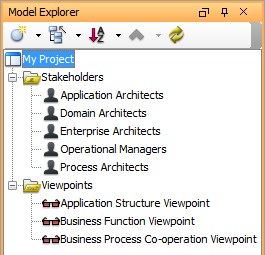
Model Explorer - If you want to browse enterprise architecture base on a stakeholder or viewpoint, double click on it.
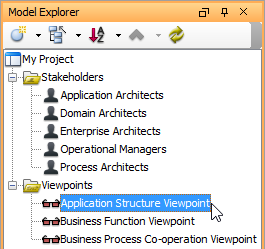
Browse an enterprise architecture from viewpoint
You will see the diagram(s) that is associated with the chosen stakeholder/viewpoint will be displayed.
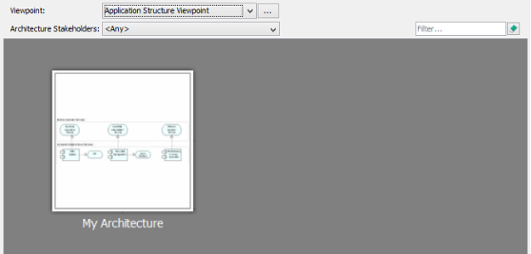
Browsing enterprise architecture - If you want to browse with another stakeholder/viewpoint, you can update the selection in the drop down at the top of the panel.
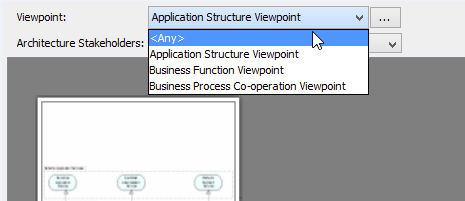
View another stakeholder
List of Standard ArchiMate 3.0 Viewpoints
|
|||||||||||||||||||||||||||||||||||||
| ArchiMate 3.0 Viewpoints |
Related Resources
The following resources may help you to learn more about the topic discussed in this page.
- What's New in ArchiMate 3? - An overview of changes in ArchiMate 3.0
- Full ArchiMate Viewpoints Guide (Examples Included) - A 'handbook' of ArchiMate Viewpoints, which lists and explains all to 23 example ArchiMate Viewpoints in detail
- ArchiMate 3.0.1 specification
- Learn more about Visual Paradigm's ArchiMate support
- Visual Paradigm on YouTube
| Chapter 2. ArchiMate Viewpoints | Table of Contents | Chapter 3. Example Viewpoints |
